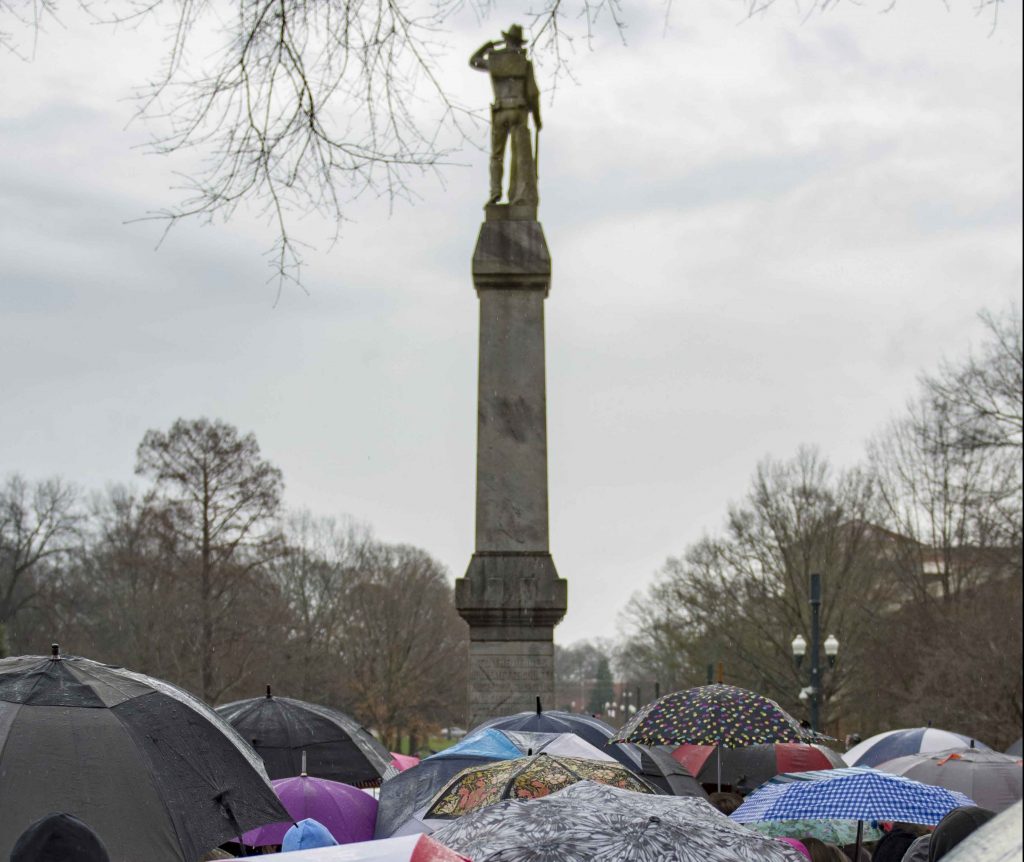
The Institutions of Higher Learning (IHL) Board of Trustees removed the proposal to relocate the Confederate monument from the Circle to the campus Confederate cemetery from their monthly meeting agenda last Thursday.
IHL Trustee Tom Duff, who made the motion, said he wants more information from the university on the progress made toward implementing recommendations from the 2017 contextualization report from the Chancellor’s Advisory Committee on History and Contextualization. Specifically, Duff wants more information regarding the status of the proposed improvements to the campus cemetery.
The IHL vote is the final step in approving the relocation of the monument, which has already been approved by all four UM governing bodies and the Mississippi Department of Archives and History. On the same day that the IHL removed the proposal from its agenda, Sen. Joseph Seymour of Vancleave introduced a bill that, if passed, would prevent public governing bodies from altering or relocating most war memorials, including those from the Civil War.
The proposals related to Duff’s request made up one page of the 49-page final report. The committee recommended “the placement of headstones for the Confederate dead in the university’s cemetery to recognize their sacrifice, and the placement of an appropriate marker to recognize the men from Lafayette County who served in the United States Colored Troops during the Civil War.”
The recommendations, requested by then-Chancellor Jeffrey Vitter, resulted in the six contextualization plaques unveiled on campus in March 2018. The Committee made a number of additional recommendations, including those regarding the cemetery. Anne Twitty, associate professor of history, served on the committee and said that the Confederate monument was an issue off-limits to them.
“Chancellor Vitter very much spelled out that from his perspective, we contextualized the Confederate monument, and we were not to make further recommendations related to the monument,” Twitty said.
Twitty also explained that a lack of historical documentation of the cemetery makes placing Confederate headstones very difficult logistically. Names are known for only a small percentage of the soldiers buried in the cemetery, and specific burial locations are known for just a few of them.
“Obviously you can’t place you can place a marker that just says ‘here is a grave,’’’ Twitty said.
Still, no formal commitment to implementing the recommendations was ever made. Twitty said Vitter expressed interest in them, but he said more public input was needed first.
IHL Commissioner of Higher Education Alfred Rankins, Jr., told The Daily Mississippian in a statement that the board will take up the relocation item after the university provides them with a report on those proposals for contextualizing the cemetery. Chancellor Glenn Boyce will have to resubmit the proposal to the board after that is done.
“We are committed to working with the board to accomplish our goal of relocating the monument. We appreciate all of the work that our campus constituents and others have put forward on this important issue for our university,” Boyce said in a statement on Jan. 16.
The 30-foot monument was erected in 1906 by the United Daughters of the Confederacy. Located prominently in the Circle, it serves as the most visible piece of Confederate iconography on a campus with many reminders of the state and university’s racially violent history.
Debate about Confederate symbols on campus has occurred since the 1970s, but the current movement to relocate the monument began in 2018 when Students Against Social Injustice began pushing the university to remove the statue. In January of last year, six student leaders met in secret for weeks to draft a resolution to the Associated Student Body Senate that called instead for relocation.
“The entire process has been postponed for several decades, and so I think one more delay is not radically outside of what they’ve done in the past,” said Jarvis Benson, UM graduate and one of the six students who introduced the ASB resolution to relocate the monument.
“I don’t think they’re owed any more information from the university or any of the other stakeholders in this process,” he said. “Right now, they realize it’s all in their hands, and the best decision for them is no decision.”
The issue even gained national media attention in late February when Neo-Confederate activists marched from the Square to campus to protest the removal of Confederate symbols from the area. In March, all four campus government organizations passed resolutions calling for relocation.
As the monument is considered a historic landmark, state law required the university to submit a plan for relocation to the Mississippi Department of Archives and History, which was approved in December.
Though the relocation plan has been approved under state law, and by all campus governing bodies and is supported by a majority of campus constituents, the IHL board could still overrule them all.
ASB President Barron Mayfield said that he and other student leaders have met with administrators, including Chancellor Boyce and Provost Noel Wilkin, since last week’s IHL meeting. Mayfield said everyone is currently in “information gathering mode” so that the university’s next steps prevent any further delays. He doubts that this will be done in time for IHL’s February meeting, but is confident it will be during the current semester.
Mayfield doesn’t think the cemetery-related recommendations should have any bearing on relocating the monument. He thinks relocation would pay respect to those who fought and died in the Civil War, but also highlight the values that the university has now. Still, he’s worried about what happens if the college board rejects the will of the university.
“To me a big part of this is that it signals a compromise. I mean, you look at what happened at North Carolina, where their statue was just torn down the middle of the night. I don’t want to see that happen here,” Mayfield said.


























